The steering and suspension systems are important for both your safety and comfort when driving as they ensure a smooth ride as your car travels over bumpy roads. The two systems are usually talked about together as they are directly related to each other. However, what does each system do? When do you need to check these important systems? And, how can you tell if either system is damaged in some way?

What does the suspension system do?
Simply put, the suspension system connects the vehicle to its wheels. In doing so, it takes responsibility for two main functions:
- Providing a comfortable ride for the driver and passengers by smoothing out the bumps and other imperfections in the road.
- Keeping the wheels on the ground as much as possible to provide traction.
Without a suspension system, the car’s wheels would hit a bump and move up and down perpendicular to the road surface. This vertical energy would be transferred to the car’s frame, which would pull the wheels away from the road before gravity takes over and slams the car down. The suspension system must be finely tuned using a combination of springs and shock absorbers to reduce these effects for a comfortable and smooth ride.
What does the steering system do?
Basically, the steering system allows the driver to guide the vehicle. The steering wheel is connected, via the steering column and a series of pivoted joints, to the suspension system. This allows the wheels to move up and down as required by the road surface without changing the steering angle. This system also ensures that the wheels turn as required, for example the inner front wheel (which has a tighter curve than the outer one) is more sharply angled when cornering. Like the suspension system, the steering system also requires precise adjustment, as any looseness in the joints can make the steering dangerous.
When should you get your steering and suspension systems inspected?
It’s a good idea to schedule regular inspections of your steering and suspension systems. It is usually easier, cheaper and safer to discover and fix a problem before it snowballs, causing further consequences.
There are three times when you should get your steering and suspension systems inspected.
Firstly, at the following times:
- Every 50,000 miles (approximately 80,000 km).
- As part of your annual service or any time your car is in for routine service and the steering and suspension systems are accessible.
- When your tyres are replaced.
- When your brakes are serviced.
- When your oil and filters are changed.
Secondly, if you are involved in an accident where your front wheels or suspension are damaged, your entire steering and suspension systems should be checked for damage. Additionally, you should get your systems inspected if you notice any difference in your suspension or steering after any accident.
Lastly, if you notice any of the symptoms listed in the next section.
Symptoms of faulty suspension and/or steering systems
In addition to any of the points mentioned above, it is recommended that you (or your mechanic) visually inspect your steering and suspension systems if you notice any of the following symptoms:
- Nose dives, squats or rolls – when your car nose dives forward, squats backwards or rolls from side-to-side when you move in different directions.
- Bottom out – when your car doesn’t have enough suspension to absorb the bump it is driving over and the tyres hit the bottom of your car when the suspension is compressed.
- Bouncing over bumps – when your car bounces repeatedly after driving over a bump in the road.
- Bumpy ride - when you can feel every bump in the road.
- Bump steer – this happens when your car hits a bump and the wheels turn left or right without the driver turning the steering wheel.
- Oversteer / Understeer – when the rear or the front of your car loses traction when rounding a corner. This is worse when road surfaces are slippery.
- Hard steering / power steering doesn’t seem to be working – this is when it becomes more difficult to turn your steering wheel.
- Loose steering – the opposite of hard steering above, steering is now too easy and feels sloppy.
- Car pulls to one side when driving / car seems to wander down the road – this is often only noticed when the problem becomes severe. When driving, you need to hold the steering wheel in place in order to keep your car going in the right direction.
- Steering wheel jerks – while you don’t notice any (or many) other problems, your steering wheel seems to jump or jerk at irregular intervals.
- Steering wheel vibrates – from 72 km/h (approximately 45 mph) your steering wheel and car start to vibrate.
- Steering wheel wobbles – your steering wheel starts to wobble from side-to-side when you drive at a constant speed.
- Noises when turning a corner – the only symptom you notice is a knocking, clunking and/or squeaking noise when you turn a corner.
- Noises from the power steering unit – the only symptom you notice is a whining noise from the steering when you turn the wheel fully in one direction or the other.
- One low corner – in other words you notice one corner of your car is lower than the others when it is unloaded and parked on even ground.
What parts of your steering and suspension systems should you inspect?
Annual or bi-annual inspections of your steering and suspension systems should include:
- Inspecting your shocks for leaks, cracks or other damage;
- Looking for vehicle bounce, nose dives, squats or rolls;
- Spinning the tyres manually to see if there is any wobble, imbalance or uneven tyre wear;
- Checking for leakage from any of the steering components;
- Ensuring the tension in the power steering pump belt is correct;
- Bouncing the car to see if your shocks or struts are functioning correctly.
Who should inspect your steering and suspension systems?
Inspecting your steering and suspension systems requires a range of specific tools and specialist technical knowledge. As these systems are critical to your safety, it is vital that these safety inspections and repairs are carried out by a certified technician if they are beyond your expertise level and available tools.
For more information on what is causing your steering and suspension system problems check out our diagnostic center.
The content contained in this article is for entertainment and informational purposes only and should not be used in lieu of seeking professional advice from a certified technician or mechanic. We encourage you to consult with a certified technician or mechanic if you have specific questions or concerns relating to any of the topics covered herein. Under no circumstances will we be liable for any loss or damage caused by your reliance on any content.
RELATED ARTICLES
Seven reasons to visit a mechanic
The complete front end assembly check
Discover the what, why and how of car alignment
Can you drive a car with broken suspension?
How long do wheel bearings last?
Bad driving habits that you need to break





